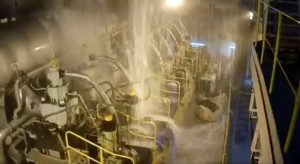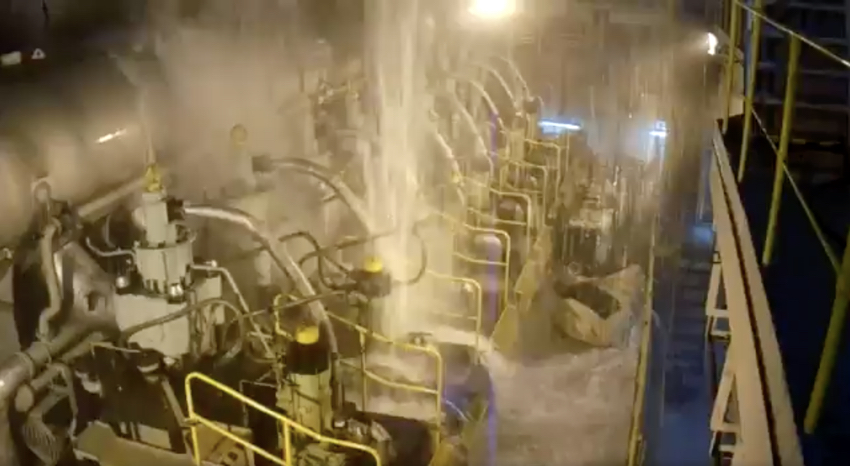Floods in a ship’s engine room can have severe consequences, compromising the vessel’s water tight integrity and potentially leading to catastrophic outcomes. The engine room is a critical area of a ship, housing essential machinery and systems that enable the vessel’s operation. Flooding in this area can occur due to various reasons, and understanding these causes, along with appropriate response measures, is vital for maintaining ship safety and functionality.

Main Reasons for Engine Room Flooding
Engine room flooding can occur due to various reasons, primarily stemming from leaks in critical systems and equipment. These leaks can arise from large sea water pumps, sea or freshwater coolers, and boiler feed water systems. Overboard valves not holding properly can also lead to water ingress, while structural issues like cracks or small holes in the hull pose a more severe threat. Understanding these potential sources of flooding is crucial for maintaining the safety and integrity of the ship.
- Leakage from Equipment and Systems: This is a common cause of engine room flooding and can occur due to leaks in machinery or sea or freshwater systems. Common sources of such leaks include large sea water pumps, sea or freshwater coolers, boiler feed water systems, and pipeline leaks.
- Leakage from Overboard Valves: This can happen if the valve after the leak is holding shut, or if the valve itself is not holding, leading to water ingress. Temporary or permanent repairs may be necessary depending on the severity and location of the leak.
- Crack in the Hull or Small Hole: These are often more serious and can compromise the ship’s stability. Immediate assistance from the nearest coastal state is crucial, and steps must be taken to minimize and eventually stop the leak. In severe cases, this may lead to a decision to abandon the ship.
Actions to Be Taken in Case of Engine Room Flooding
In the event of engine room flooding, immediate and effective action is required to control the situation. This includes mobilizing manpower to tackle the issue, quickly identifying and isolating the leak, and informing the chief engineer for guidance. Measures such as closing inlet and outlet valves to stop further leakage and transferring contents from a leaking tank are essential. Ensuring repairs like cement boxing or welding on affected tanks is also vital before they are put back into use. A summarised typical course of actions is listed :
- Inform the ship Bridge and chief engineer
- Mobilize maximum manpower to address the situation.
- Quickly identify the source of the leak and isolate the affected system by shutting valves.
- Inform the chief engineer and follow their instructions.
- Transfer contents from a leaking tank to minimize leakage.
- For tank leaks, repairs such as cement boxing or welding should be completed before reuse.
- Conduct regular maintenance and inspections of systems and structures.
- Train crew in emergency procedures and conduct regular drills.
Safety and Prevention Measures
Preventing engine room flooding involves several safety measures and proactive strategies. One key approach is implementing an “Emergency Bilge Suction Valve” for rapid response to flooding incidents. Regular inspections and maintenance of the ship’s structure, including hull penetrations, shipside valves, and other critical components, are essential. Conducting risk assessments, establishing strong isolation controls, and ensuring compliance with regulatory requirements for any external work on the ship are also important for preventing flooding.
- Implement an “Emergency Bilge Suction Valve” to prevent flooding.
- Regularly inspect and maintain the ship’s structure, including hull penetrations and shipside valves.
- Conduct risk assessments and establish robust isolation controls.
- Ensure that any external work on the hull or underwater operations complies with regulatory requirements.
Daily Maintenance to Avoid Engine Room Flooding
Daily maintenance is pivotal in preventing engine room flooding. This involves routine checks and upkeep of all equipment and systems within the engine room. Regular inspections ensure that valves, pipelines, and other components are in good working condition. Keeping the crew well-trained in emergency procedures and ensuring they are prepared to respond effectively to flooding incidents are also crucial aspects of daily maintenance and safety management.
Consistent and thorough maintenance is crucial in preventing engine room flooding. This includes:
- Regular inspections and maintenance of equipment and systems.
- Ensuring that all valves and pipelines are in good condition and functioning correctly.
- Keeping the crew well-trained and prepared for emergency situations.
Conclusion
Engine room flooding is a significant risk that can lead to serious damage and even the sinking of a ship. Understanding the causes and taking proactive measures to prevent such incidents are essential for the safety of the vessel and its crew. Regular maintenance, crew training, and adherence to safety protocols play a crucial role in mitigating the risks associated with engine room flooding.


I loved even more than you will get done right here. The overall look is nice, and the writing is stylish, but there’s something off about the way you write that makes me think that you should be careful what you say next. I will definitely be back again and again if you protect this hike.